- Home
- Edgar Allan Poe
The Works of Edgar Allan Poe — Volume 1 Page 9
The Works of Edgar Allan Poe — Volume 1 Read online
Page 9
THE BALLOON-HOAX
[Astounding News by Express, _via_ Norfolk!--The Atlantic crossed in Three Days! Signal Triumph of Mr. Monck Mason’s Flying Machine!--Arrival at Sullivan’s Island, near Charlestown, S.C., of Mr. Mason, Mr. Robert Holland, Mr. Henson, Mr. Harrison Ainsworth, and four others, in the Steering Balloon, “Victoria,” after a passage of Seventy-five Hours from Land to Land! Full Particulars of the Voyage!
The subjoined _jeu d’esprit_ with the preceding heading in magnificent capitals, well interspersed with notes of admiration, was originally published, as matter of fact, in the “New York Sun,” a daily newspaper, and therein fully subserved the purpose of creating indigestible aliment for the _quidnuncs_ during the few hours intervening between a couple of the Charleston mails. The rush for the “sole paper which had the news,” was something beyond even the prodigious; and, in fact, if (as some assert) the “Victoria” _did_ not absolutely accomplish the voyage recorded, it will be difficult to assign a reason why she _should_ not have accomplished it.]
THE great problem is at length solved! The air, as well as the earthand the ocean, has been subdued by science, and will become a common andconvenient highway for mankind. _The Atlantic has been actually crossedin a Balloon!_ and this too without difficulty--without any greatapparent danger--with thorough control of the machine--and in theinconceivably brief period of seventy-five hours from shore to shore!By the energy of an agent at Charleston, S.C., we are enabled to bethe first to furnish the public with a detailed account of this mostextraordinary voyage, which was performed between Saturday, the 6thinstant, at 11, A.M., and 2, P.M., on Tuesday, the 9th instant, by SirEverard Bringhurst; Mr. Osborne, a nephew of Lord Bentinck’s; Mr. MonckMason and Mr. Robert Holland, the well-known æronauts; Mr. HarrisonAinsworth, author of “Jack Sheppard,” &c.; and Mr. Henson, theprojector of the late unsuccessful flying machine--with two seamen fromWoolwich--in all, eight persons. The particulars furnished below may berelied on as authentic and accurate in every respect, as, with a slightexception, they are copied _verbatim_ from the joint diaries of Mr.Monck Mason and Mr. Harrison Ainsworth, to whose politeness our agent isalso indebted for much verbal information respecting the balloon itself,its construction, and other matters of interest. The only alteration inthe MS. received, has been made for the purpose of throwing the hurriedaccount of our agent, Mr. Forsyth, into a connected and intelligibleform.
“THE BALLOON.
“Two very decided failures, of late--those of Mr. Henson and Sir GeorgeCayley--had much weakened the public interest in the subject of aerialnavigation. Mr. Henson’s scheme (which at first was considered veryfeasible even by men of science,) was founded upon the principle of aninclined plane, started from an eminence by an extrinsic force, appliedand continued by the revolution of impinging vanes, in form and numberresembling the vanes of a windmill. But, in all the experiments madewith models at the Adelaide Gallery, it was found that the operation ofthese fans not only did not propel the machine, but actually impededits flight. The only propelling force it ever exhibited, was the mere_impetus_ acquired from the descent of the inclined plane; and this_impetus_ carried the machine farther when the vanes were at rest, thanwhen they were in motion--a fact which sufficiently demonstrates theirinutility; and in the absence of the propelling, which was also the_sustaining_ power, the whole fabric would necessarily descend.This consideration led Sir George Cayley to think only of adaptinga propeller to some machine having of itself an independent power ofsupport--in a word, to a balloon; the idea, however, being novel,or original, with Sir George, only so far as regards the mode of itsapplication to practice. He exhibited a model of his invention at thePolytechnic Institution. The propelling principle, or power, was here,also, applied to interrupted surfaces, or vanes, put in revolution.These vanes were four in number, but were found entirely ineffectual inmoving the balloon, or in aiding its ascending power. The whole projectwas thus a complete failure.
“It was at this juncture that Mr. Monck Mason (whose voyage from Doverto Weilburg in the balloon, “Nassau,” occasioned so much excitement in1837,) conceived the idea of employing the principle of the Archimedeanscrew for the purpose of propulsion through the air--rightlyattributing the failure of Mr. Henson’s scheme, and of Sir GeorgeCayley’s, to the interruption of surface in the independent vanes.He made the first public experiment at Willis’s Rooms, but afterwardremoved his model to the Adelaide Gallery.
“Like Sir George Cayley’s balloon, his own was an ellipsoid. Itslength was thirteen feet six inches--height, six feet eight inches. Itcontained about three hundred and twenty cubic feet of gas, which, ifpure hydrogen, would support twenty-one pounds upon its first inflation,before the gas has time to deteriorate or escape. The weight of thewhole machine and apparatus was seventeen pounds--leaving about fourpounds to spare. Beneath the centre of the balloon, was a frame of lightwood, about nine feet long, and rigged on to the balloon itself witha network in the customary manner. From this framework was suspended awicker basket or car.
“The screw consists of an axis of hollow brass tube, eighteen inches inlength, through which, upon a semi-spiral inclined at fifteen degrees,pass a series of steel wire radii, two feet long, and thus projecting afoot on either side. These radii are connected at the outer extremitiesby two bands of flattened wire--the whole in this manner forming theframework of the screw, which is completed by a covering of oiled silkcut into gores, and tightened so as to present a tolerably uniformsurface. At each end of its axis this screw is supported by pillars ofhollow brass tube descending from the hoop. In the lower ends of thesetubes are holes in which the pivots of the axis revolve. From the endof the axis which is next the car, proceeds a shaft of steel, connectingthe screw with the pinion of a piece of spring machinery fixed in thecar. By the operation of this spring, the screw is made to revolve withgreat rapidity, communicating a progressive motion to the whole. Bymeans of the rudder, the machine was readily turned in any direction.The spring was of great power, compared with its dimensions, beingcapable of raising forty-five pounds upon a barrel of four inchesdiameter, after the first turn, and gradually increasing as it was woundup. It weighed, altogether, eight pounds six ounces. The rudder wasa light frame of cane covered with silk, shaped somewhat like abattle-door, and was about three feet long, and at the widest, one foot.Its weight was about two ounces. It could be turned _flat_, and directedupwards or downwards, as well as to the right or left; and thus enabledthe æronaut to transfer the resistance of the air which in an inclinedposition it must generate in its passage, to any side upon which hemight desire to act; thus determining the balloon in the oppositedirection.
“This model (which, through want of time, we have necessarily describedin an imperfect manner,) was put in action at the Adelaide Gallery,where it accomplished a velocity of five miles per hour; although,strange to say, it excited very little interest in comparison with theprevious complex machine of Mr. Henson--so resolute is the worldto despise anything which carries with it an air of simplicity. Toaccomplish the great desideratum of ærial navigation, it was verygenerally supposed that some exceedingly complicated application must bemade of some unusually profound principle in dynamics.
“So well satisfied, however, was Mr. Mason of the ultimate success ofhis invention, that he determined to construct immediately, if possible,a balloon of sufficient capacity to test the question by a voyage ofsome extent--the original design being to cross the British Channel, asbefore, in the Nassau balloon. To carry out his views, he solicited andobtained the patronage of Sir Everard Bringhurst and Mr. Osborne, twogentlemen well known for scientific acquirement, and especially for theinterest they have exhibited in the progress of ærostation. The project,at the desire of Mr. Osborne, was kept a profound secret from thepublic--the only persons entrusted with the design being those actuallyengaged in the construction of the machine, which was built (under thesuperintendence of Mr. Mason, Mr. Holland, Sir Everard Bringhurst, andMr. Osborne,) at the seat of the latter
gentleman near Penstruthal, inWales. Mr. Henson, accompanied by his friend Mr. Ainsworth, was admittedto a private view of the balloon, on Saturday last--when the twogentlemen made final arrangements to be included in the adventure. Weare not informed for what reason the two seamen were also included inthe party--but, in the course of a day or two, we shall put our readersin possession of the minutest particulars respecting this extraordinaryvoyage.
“The balloon is composed of silk, varnished with the liquid gumcaoutchouc. It is of vast dimensions, containing more than 40,000 cubicfeet of gas; but as coal gas was employed in place of the more expensiveand inconvenient hydrogen, the supporting power of the machine, whenfully inflated, and immediately after inflation, is not more than about2500 pounds. The coal gas is not only much less costly, but is easilyprocured and managed.
“For its introduction into common use for purposes of aerostation, weare indebted to Mr. Charles Green. Up to his discovery, the process ofinflation was not only exceedingly expensive, but uncertain. Two, andeven three days, have frequently been wasted in futile attempts toprocure a sufficiency of hydrogen to fill a balloon, from which ithad great tendency to escape, owing to its extreme subtlety, and itsaffinity for the surrounding atmosphere. In a balloon sufficientlyperfect to retain its contents of coal-gas unaltered, in quantity oramount, for six months, an equal quantity of hydrogen could not bemaintained in equal purity for six weeks.
“The supporting power being estimated at 2500 pounds, and the unitedweights of the party amounting only to about 1200, there was left asurplus of 1300, of which again 1200 was exhausted by ballast, arrangedin bags of different sizes, with their respective weights marked uponthem--by cordage, barometers, telescopes, barrels containing provisionfor a fortnight, water-casks, cloaks, carpet-bags, and various otherindispensable matters, including a coffee-warmer, contrived for warmingcoffee by means of slack-lime, so as to dispense altogether with fire,if it should be judged prudent to do so. All these articles, with theexception of the ballast, and a few trifles, were suspended from thehoop overhead. The car is much smaller and lighter, in proportion, thanthe one appended to the model. It is formed of a light wicker, and iswonderfully strong, for so frail looking a machine. Its rim is aboutfour feet deep. The rudder is also very much larger, in proportion, thanthat of the model; and the screw is considerably smaller. The balloon isfurnished besides with a grapnel, and a guide-rope; which latter is ofthe most indispensable importance. A few words, in explanation, willhere be necessary for such of our readers as are not conversant with thedetails of aerostation.
“As soon as the balloon quits the earth, it is subjected to theinfluence of many circumstances tending to create a difference in itsweight; augmenting or diminishing its ascending power. For example,there may be a deposition of dew upon the silk, to the extent, even,of several hundred pounds; ballast has then to be thrown out, or themachine may descend. This ballast being discarded, and a clear sunshineevaporating the dew, and at the same time expanding the gas in the silk,the whole will again rapidly ascend. To check this ascent, the onlyrecourse is, (or rather _was_, until Mr. Green’s invention of theguide-rope,) the permission of the escape of gas from the valve; but, inthe loss of gas, is a proportionate general loss of ascending power; sothat, in a comparatively brief period, the best-constructed balloon mustnecessarily exhaust all its resources, and come to the earth. This wasthe great obstacle to voyages of length.
“The guide-rope remedies the difficulty in the simplest mannerconceivable. It is merely a very long rope which is suffered to trailfrom the car, and the effect of which is to prevent the balloon fromchanging its level in any material degree. If, for example, there shouldbe a deposition of moisture upon the silk, and the machine begins todescend in consequence, there will be no necessity for dischargingballast to remedy the increase of weight, for it is remedied, orcounteracted, in an exactly just proportion, by the deposit on theground of just so much of the end of the rope as is necessary. If,on the other hand, any circumstances should cause undue levity, andconsequent ascent, this levity is immediately counteracted by theadditional weight of rope upraised from the earth. Thus, the ballooncan neither ascend or descend, except within very narrow limits, and itsresources, either in gas or ballast, remain comparatively unimpaired.When passing over an expanse of water, it becomes necessary to employsmall kegs of copper or wood, filled with liquid ballast of a lighternature than water. These float, and serve all the purposes of a mererope on land. Another most important office of the guide-rope, is topoint out the _direction_ of the balloon. The rope _drags_, either onland or sea, while the balloon is free; the latter, consequently, isalways in advance, when any progress whatever is made: a comparison,therefore, by means of the compass, of the relative positions of the twoobjects, will always indicate the _course_. In the same way, the angleformed by the rope with the vertical axis of the machine, indicatesthe _velocity_. When there is _no_ angle--in other words, when the ropehangs perpendicularly, the whole apparatus is stationary; but the largerthe angle, that is to say, the farther the balloon precedes the end ofthe rope, the greater the velocity; and the converse.
“As the original design was to cross the British Channel, and alight asnear Paris as possible, the voyagers had taken the precaution to preparethemselves with passports directed to all parts of the Continent,specifying the nature of the expedition, as in the case of the Nassauvoyage, and entitling the adventurers to exemption from the usualformalities of office: unexpected events, however, rendered thesepassports superfluous.
“The inflation was commenced very quietly at daybreak, on Saturdaymorning, the 6th instant, in the Court-Yard of Weal-Vor House, Mr.Osborne’s seat, about a mile from Penstruthal, in North Wales; and at 7minutes past 11, every thing being ready for departure, the balloon wasset free, rising gently but steadily, in a direction nearly South; nouse being made, for the first half hour, of either the screw or therudder. We proceed now with the journal, as transcribed by Mr. Forsythfrom the joint MSS. Of Mr. Monck Mason, and Mr. Ainsworth. The body ofthe journal, as given, is in the hand-writing of Mr. Mason, and a P.S. is appended, each day, by Mr. Ainsworth, who has in preparation, andwill shortly give the public a more minute, and no doubt, a thrillinglyinteresting account of the voyage.
“THE JOURNAL.
“_Saturday, April the 6th_.--Every preparation likely to embarrass us,having been made over night, we commenced the inflation this morning atdaybreak; but owing to a thick fog, which encumbered the folds of thesilk and rendered it unmanageable, we did not get through before nearlyeleven o’clock. Cut loose, then, in high spirits, and rose gently butsteadily, with a light breeze at North, which bore us in the directionof the British Channel. Found the ascending force greater than we hadexpected; and as we arose higher and so got clear of the cliffs, andmore in the sun’s rays, our ascent became very rapid. I did not wish,however, to lose gas at so early a period of the adventure, and soconcluded to ascend for the present. We soon ran out our guide-rope;but even when we had raised it clear of the earth, we still went up veryrapidly. The balloon was unusually steady, and looked beautifully. Inabout ten minutes after starting, the barometer indicated an altitudeof 15,000 feet. The weather was remarkably fine, and the view of thesubjacent country--a most romantic one when seen from any point,--wasnow especially sublime. The numerous deep gorges presented theappearance of lakes, on account of the dense vapors with which theywere filled, and the pinnacles and crags to the South East, piled ininextricable confusion, resembling nothing so much as the giant citiesof eastern fable. We were rapidly approaching the mountains in theSouth; but our elevation was more than sufficient to enable us to passthem in safety. In a few minutes we soared over them in fine style; andMr. Ainsworth, with the seamen, was surprised at their apparent want ofaltitude when viewed from the car, the tendency of great elevation in aballoon being to reduce inequalities of the surface below, to nearlya dead level. At half-past eleven still proceeding nearly South, weobtained our first view of the Bristol Channel; and, in
fifteen minutesafterward, the line of breakers on the coast appeared immediatelybeneath us, and we were fairly out at sea. We now resolved to let offenough gas to bring our guide-rope, with the buoys affixed, into thewater. This was immediately done, and we commenced a gradual descent.In about twenty minutes our first buoy dipped, and at the touch of thesecond soon afterwards, we remained stationary as to elevation. We wereall now anxious to test the efficiency of the rudder and screw, and weput them both into requisition forthwith, for the purpose of alteringour direction more to the eastward, and in a line for Paris. By means ofthe rudder we instantly effected the necessary change of direction, andour course was brought nearly at right angles to that of the wind; whenwe set in motion the spring of the screw, and were rejoiced to find itpropel us readily as desired. Upon this we gave nine hearty cheers, anddropped in the sea a bottle, enclosing a slip of parchment with a briefaccount of the principle of the invention. Hardly, however, had wedone with our rejoicings, when an unforeseen accident occurred whichdiscouraged us in no little degree. The steel rod connecting the springwith the propeller was suddenly jerked out of place, at the car end, (bya swaying of the car through some movement of one of the two seamen wehad taken up,) and in an instant hung dangling out of reach, from thepivot of the axis of the screw. While we were endeavoring to regain it,our attention being completely absorbed, we became involved in a strongcurrent of wind from the East, which bore us, with rapidly increasingforce, towards the Atlantic. We soon found ourselves driving out to seaat the rate of not less, certainly, than fifty or sixty miles an hour,so that we came up with Cape Clear, at some forty miles to our North,before we had secured the rod, and had time to think what we were about.It was now that Mr. Ainsworth made an extraordinary, but to my fancy,a by no means unreasonable or chimerical proposition, in which he wasinstantly seconded by Mr. Holland--viz.: that we should take advantageof the strong gale which bore us on, and in place of beating back toParis, make an attempt to reach the coast of North America. After slightreflection I gave a willing assent to this bold proposition, which(strange to say) met with objection from the two seamen only. As thestronger party, however, we overruled their fears, and kept resolutelyupon our course. We steered due West; but as the trailing of the buoysmaterially impeded our progress, and we had the balloon abundantly atcommand, either for ascent or descent, we first threw out fifty poundsof ballast, and then wound up (by means of a windlass) so much of therope as brought it quite clear of the sea. We perceived the effect ofthis manoeuvre immediately, in a vastly increased rate of progress; and,as the gale freshened, we flew with a velocity nearly inconceivable; theguide-rope flying out behind the car, like a streamer from a vessel. Itis needless to say that a very short time sufficed us to lose sight ofthe coast. We passed over innumerable vessels of all kinds, a few ofwhich were endeavoring to beat up, but the most of them lying to. Weoccasioned the greatest excitement on board all--an excitement greatlyrelished by ourselves, and especially by our two men, who, now under theinfluence of a dram of Geneva, seemed resolved to give all scruple, orfear, to the wind. Many of the vessels fired signal guns; and in allwe were saluted with loud cheers (which we heard with surprisingdistinctness) and the waving of caps and handkerchiefs. We kept on inthis manner throughout the day, with no material incident, and, asthe shades of night closed around us, we made a rough estimate of thedistance traversed. It could not have been less than five hundredmiles, and was probably much more. The propeller was kept in constantoperation, and, no doubt, aided our progress materially. As the sunwent down, the gale freshened into an absolute hurricane, and the oceanbeneath was clearly visible on account of its phosphorescence. The windwas from the East all night, and gave us the brightest omen of success.We suffered no little from cold, and the dampness of the atmosphere wasmost unpleasant; but the ample space in the car enabled us to lie down,and by means of cloaks and a few blankets, we did sufficiently well.
“P.S. (by Mr. Ainsworth.) The last nine hours have been unquestionablythe most exciting of my life. I can conceive nothing more sublimatingthan the strange peril and novelty of an adventure such as this. MayGod grant that we succeed! I ask not success for mere safety to myinsignificant person, but for the sake of human knowledge and--for thevastness of the triumph. And yet the feat is only so evidently feasiblethat the sole wonder is why men have scrupled to attempt it before. Onesingle gale such as now befriends us--let such a tempest whirl forwarda balloon for four or five days (these gales often last longer) and thevoyager will be easily borne, in that period, from coast to coast. Inview of such a gale the broad Atlantic becomes a mere lake. I am morestruck, just now, with the supreme silence which reigns in thesea beneath us, notwithstanding its agitation, than with any otherphenomenon presenting itself. The waters give up no voice tothe heavens. The immense flaming ocean writhes and is tortureduncomplainingly. The mountainous surges suggest the idea of innumerabledumb gigantic fiends struggling in impotent agony. In a night such as isthis to me, a man _lives_--lives a whole century of ordinary life--norwould I forego this rapturous delight for that of a whole century ofordinary existence.
“_Sunday, the seventh_. [Mr. Mason’s MS.] This morning the gale, by 10,had subsided to an eight or nine--knot breeze, (for a vessel at sea,)and bears us, perhaps, thirty miles per hour, or more. It has veered,however, very considerably to the north; and now, at sundown, we areholding our course due west, principally by the screw and rudder, whichanswer their purposes to admiration. I regard the project as thoroughlysuccessful, and the easy navigation of the air in any direction (notexactly in the teeth of a gale) as no longer problematical. We could nothave made head against the strong wind of yesterday; but, by ascending,we might have got out of its influence, if requisite. Against a prettystiff breeze, I feel convinced, we can make our way with the propeller.At noon, to-day, ascended to an elevation of nearly 25,000 feet, bydischarging ballast. Did this to search for a more direct current, butfound none so favorable as the one we are now in. We have an abundanceof gas to take us across this small pond, even should the voyagelast three weeks. I have not the slightest fear for the result. Thedifficulty has been strangely exaggerated and misapprehended. I canchoose my current, and should I find _all_ currents against me, I canmake very tolerable headway with the propeller. We have had no incidentsworth recording. The night promises fair.
P.S. [By Mr. Ainsworth.] I have little to record, except the fact (to mequite a surprising one) that, at an elevation equal to that of Cotopaxi,I experienced neither very intense cold, nor headache, nor difficultyof breathing; neither, I find, did Mr. Mason, nor Mr. Holland, nor SirEverard. Mr. Osborne complained of constriction of the chest--but thissoon wore off. We have flown at a great rate during the day, and wemust be more than half way across the Atlantic. We have passed oversome twenty or thirty vessels of various kinds, and all seem to bedelightfully astonished. Crossing the ocean in a balloon is not sodifficult a feat after all. _Omne ignotum pro magnifico. Mem:_ at25,000 feet elevation the sky appears nearly black, and the stars aredistinctly visible; while the sea does not seem convex (as one mightsuppose) but absolutely and most unequivocally _concave_.(*1)
“_Monday, the 8th_. [Mr. Mason’s MS.] This morning we had again somelittle trouble with the rod of the propeller, which must be entirelyremodelled, for fear of serious accident--I mean the steel rod--notthe vanes. The latter could not be improved. The wind has been blowingsteadily and strongly from the north-east all day and so far fortuneseems bent upon favoring us. Just before day, we were all somewhatalarmed at some odd noises and concussions in the balloon, accompaniedwith the apparent rapid subsidence of the whole machine. These phenomenawere occasioned by the expansion of the gas, through increase of heat inthe atmosphere, and the consequent disruption of the minute particles ofice with which the network had become encrusted during the night. Threwdown several bottles to the vessels below. Saw one of them picked up bya large ship--seemingly one of the New York line packets. Endeavored tomake out her name, but could not be sure of it. Mr. Osbor
ne’s telescopemade it out something like “Atalanta.” It is now 12, at night, and weare still going nearly west, at a rapid pace. The sea is peculiarlyphosphorescent.
“P.S. [By Mr. Ainsworth.] It is now 2, A.M., and nearly calm, as well asI can judge--but it is very difficult to determine this point, sincewe move _with_ the air so completely. I have not slept since quittingWheal-Vor, but can stand it no longer, and must take a nap. We cannot befar from the American coast.
“_Tuesday, the _9_th_. [Mr. Ainsworth’s MS.] _One, P.M. We are infull view of the low coast of South Carolina_. The great problem isaccomplished. We have crossed the Atlantic--fairly and _easily_crossed it in a balloon! God be praised! Who shall say that anything isimpossible hereafter?”
The Journal here ceases. Some particulars of the descent werecommunicated, however, by Mr. Ainsworth to Mr. Forsyth. It was nearlydead calm when the voyagers first came in view of the coast, whichwas immediately recognized by both the seamen, and by Mr. Osborne.The latter gentleman having acquaintances at Fort Moultrie, it wasimmediately resolved to descend in its vicinity. The balloon was broughtover the beach (the tide being out and the sand hard, smooth, andadmirably adapted for a descent,) and the grapnel let go, which tookfirm hold at once. The inhabitants of the island, and of the fort,thronged out, of course, to see the balloon; but it was with thegreatest difficulty that any one could be made to credit the actualvoyage--_the crossing of the Atlantic_. The grapnel caught at 2, P.M.,precisely; and thus the whole voyage was completed in seventy-fivehours; or rather less, counting from shore to shore. No serious accidentoccurred. No real danger was at any time apprehended. The balloon wasexhausted and secured without trouble; and when the MS. from which thisnarrative is compiled was despatched from Charleston, the party werestill at Fort Moultrie. Their farther intentions were not ascertained;but we can safely promise our readers some additional information eitheron Monday or in the course of the next day, at farthest.
This is unquestionably the most stupendous, the most interesting, andthe most important undertaking, ever accomplished or even attempted byman. What magnificent events may ensue, it would be useless now to thinkof determining.
(*1) _Note_.--Mr. Ainsworth has not attempted to account for thisphenomenon, which, however, is quite susceptible of explanation. A linedropped from an elevation of 25,000 feet, perpendicularly to the surfaceof the earth (or sea), would form the perpendicular of a right-angledtriangle, of which the base would extend from the right angle to thehorizon, and the hypothenuse from the horizon to the balloon. But the25,000 feet of altitude is little or nothing, in comparison with theextent of the prospect. In other words, the base and hypothenuse of thesupposed triangle would be so long when compared with the perpendicular,that the two former may be regarded as nearly parallel. In this mannerthe horizon of the æronaut would appear to be _on a level_ with thecar. But, as the point immediately beneath him seems, and is, at a greatdistance below him, it seems, of course, also, at a great distance belowthe horizon. Hence the impression of _concavity_; and this impressionmust remain, until the elevation shall bear so great a proportion tothe extent of prospect, that the apparent parallelism of the base andhypothenuse disappears--when the earth’s real convexity must becomeapparent.

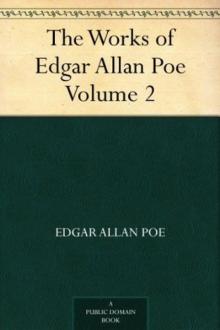 The Works of Edgar Allan Poe — Volume 2
The Works of Edgar Allan Poe — Volume 2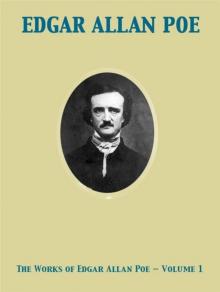 The Works of Edgar Allan Poe — Volume 1
The Works of Edgar Allan Poe — Volume 1 The Works of Edgar Allan Poe — Volume 3
The Works of Edgar Allan Poe — Volume 3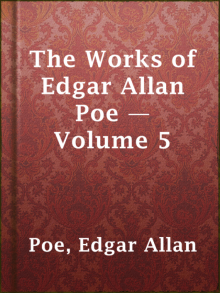 The Works of Edgar Allan Poe — Volume 5
The Works of Edgar Allan Poe — Volume 5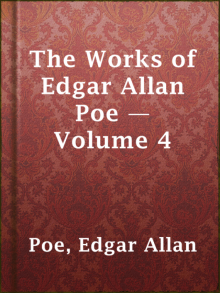 The Works of Edgar Allan Poe — Volume 4
The Works of Edgar Allan Poe — Volume 4 The Tell-Tale Heart
The Tell-Tale Heart The Raven (Penguin)
The Raven (Penguin) The Paris Mysteries
The Paris Mysteries Tales of Terror from Edgar Allan Poe
Tales of Terror from Edgar Allan Poe The Fall of the House of Usher
The Fall of the House of Usher The Golden Book of World's Greatest Mysteries
The Golden Book of World's Greatest Mysteries The Narrative of Arthur Gordon Pym of Nantucket
The Narrative of Arthur Gordon Pym of Nantucket Ligeia
Ligeia The Landscape Garden
The Landscape Garden Complete Tales & Poems
Complete Tales & Poems Great Tales and Poems of Edgar Allan Poe
Great Tales and Poems of Edgar Allan Poe The Colloquy of Monos and Una
The Colloquy of Monos and Una The Oblong Box
The Oblong Box Thou Art the Man
Thou Art the Man A DESCENT INTO THE MAELSTROM
A DESCENT INTO THE MAELSTROM THE MURDERS IN THE RUE MORGUE
THE MURDERS IN THE RUE MORGUE The Business Man
The Business Man The Mystery of Marie Rogêt
The Mystery of Marie Rogêt Metzengerstein
Metzengerstein The Man That Was Used Up
The Man That Was Used Up William Wilson
William Wilson The Philosophy of Composition
The Philosophy of Composition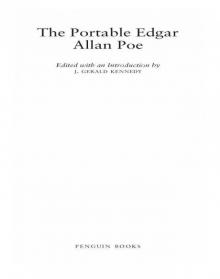 The Portable Edgar Allan Poe
The Portable Edgar Allan Poe Bon-Bon
Bon-Bon A Predicament
A Predicament The Premature Burial
The Premature Burial The Angel of the Odd
The Angel of the Odd The Man of the Crowd
The Man of the Crowd Never Bet the Devil Your Head
Never Bet the Devil Your Head The Tell-Tale Heart and Other Writings
The Tell-Tale Heart and Other Writings The System of Doctor Tarr and Professor Fether
The System of Doctor Tarr and Professor Fether Selected Tales (Oxford World's Classics)
Selected Tales (Oxford World's Classics) Essential Tales and Poems of Edgar Allan Poe (Barnes & Noble Classics Series)
Essential Tales and Poems of Edgar Allan Poe (Barnes & Noble Classics Series) MS. Found in a Bottle
MS. Found in a Bottle Some Words with a Mummy
Some Words with a Mummy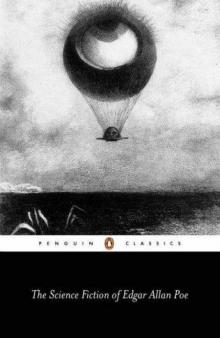 The Science Fiction of Edgar Allan Poe (Penguin Classics)
The Science Fiction of Edgar Allan Poe (Penguin Classics) King Pest
King Pest CRITICISM
CRITICISM How to Write a Blackwood Article
How to Write a Blackwood Article Mystification
Mystification Diddling Considered as One of the Exact Sciences
Diddling Considered as One of the Exact Sciences Steampunk Poe
Steampunk Poe The Literary Life of Thingum Bob, Esq.
The Literary Life of Thingum Bob, Esq. Classic Crime Collection
Classic Crime Collection Complete Stories and Poems of Edgar Allen Poe
Complete Stories and Poems of Edgar Allen Poe Berenice
Berenice The Black Cat
The Black Cat The Slender Poe Anthology
The Slender Poe Anthology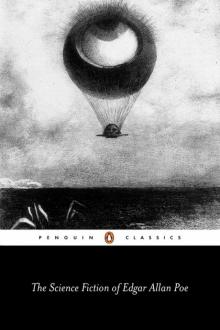 The Science Fiction of Edgar Allan Poe
The Science Fiction of Edgar Allan Poe The Assignation
The Assignation The Thousand-and-Second Tale of Scheherazade
The Thousand-and-Second Tale of Scheherazade The Raven and Other Short Stories
The Raven and Other Short Stories The Spectacles
The Spectacles Hop-Frog
Hop-Frog The Purloined Letter
The Purloined Letter Mellonta Tauta
Mellonta Tauta The Balloon-Hoax
The Balloon-Hoax Landor's Cottage
Landor's Cottage Mesmeric Revelation
Mesmeric Revelation The Pit and the Pendulum
The Pit and the Pendulum